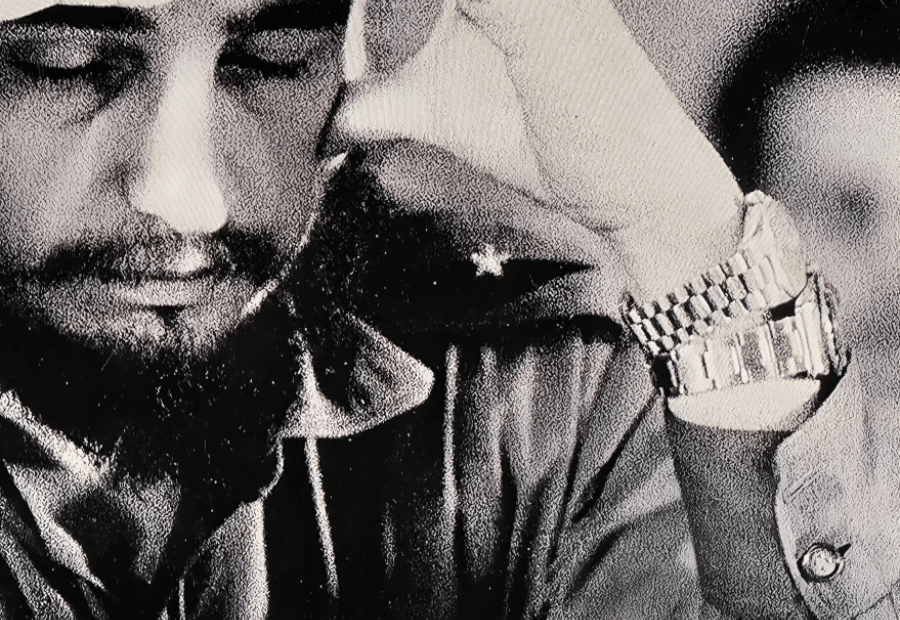Fidel Castro, iconic Cuban Revolution leader, was famed for his political strategies, fiery speeches, and unique style. Fidel Castro’s love for watches, especially his habit of wearing two on the same wrist, offers a fascinating glimpse into the complexities of his personality and leadership.
Castro’s Watch-Wearing Style
From a young age, Castro’s meticulous attention to time ensured punctuality at all appointments and public events. This precision was crucial in his military and political strategies, reinforcing the importance of time management in revolutionary activities.
The Double Wrist Phenomenon
Castro’s practice of wearing two watches became legendary. Initially, wearing multiple watches was practical for tracking time zones during international visits in the Cold War. However, it soon evolved into a personal trademark. Thus, wearing two watches, he could simultaneously monitor the time in Cuba while keeping an eye on the time zone of another strategic country.
Types of Watches Favoured
Castro was often seen wearing robust, durable watches. Brands like Rolex and Omega were among his favorites. These were not just functional but also served as subtle statements of reliability and endurance—qualities he admired and embodied.
Symbolism and Practicality
For Castro, time was a valuable resource. Punctuality was a form of respect for others’ time and highlighted his disciplined approach to governance and military operations.
Furthermore, dual watches symbolized dual vigilance—over his regime and the movements of the opposition. His followers and critics noted that his watches reflected his intense focus and constant readiness.
Historians often regard Castro’s watches as an emblem of his layered leadership style. They suggest that his timepieces reflect the perpetual alertness required of a man in his position, constantly navigating complex domestic and international politics.
Personal Anecdotes and Public Appearances
Castro’s watches were almost always visible during important speeches and international trips, peeking out from under his sleeve. They were there during his hours-long speeches and meetings with other world leaders, ticking away the minutes and hours of his lengthy rule.
The public and media often speculated about the reasons behind his double watches, with opinions ranging from admiration to mockery. However, for Castro, they remained a practical tool rather than a fashion statement.
Those close to Castro noted that his watches were among his most prized possessions. They were not just accessories but companions that marked his life and leadership moments.
Significance of Fidel Castro’s Love For Watches In Diplomatic Relations
The exchange of watches in diplomatic settings can serve multiple purposes: as gestures of goodwill, symbols of mutual respect, and even as tools of soft power. In the case of Fidel Castro, a leader known for his symbolic defiance against capitalist ideologies yet often seen wearing luxury watches, these gifts took on layered meanings. This section explores various instances where watches featured in Castro’s diplomatic interactions and assesses their significance.
Instances of Watch Exchanges
- Gifts Received from Other Leaders:
- Fidel Castro is known to have received several luxury watches from other heads of state and dignitaries. The givers likely chose these gifts for their universal appeal and high value, symbolizing respect and high regard. For instance, receiving watches from Soviet leaders during the Cold War could have symbolized a bond or alliance, as these gifts were not merely personal but carried political weight.
- Gifts Given to Foreign Leaders:
- Castro was known to give watches as gifts, which might have served as personal gestures and symbols of Cuban generosity. By gifting watches, Castro aimed to portray Cuba as gracious and sophisticated, crucial for strengthening diplomatic ties.
Symbolic Meanings and Diplomatic Implications
- Symbolism in International Relations:
- In diplomacy, watches symbolize a commitment to timeless friendship and reliability. For Castro, giving or receiving watches symbolized his dual nature of revolutionary simplicity and complex leadership.
- Facilitating Diplomatic Relationships:
- In diplomacy, gifts can smooth over political differences or soften negotiations. Castro’s exchange of luxury watches fostered personal connections and strengthened diplomatic bonds.
- Contradictions and Perceptions:
- For Castro, wearing and exchanging watches that were often seen as symbols of capitalist excess could seem contradictory to his avowed Marxist-Leninist principles. However, such actions might also be interpreted as a sophisticated strategy to engage with world leaders on their terms while maintaining his own ideological stance. It highlighted his pragmatic approach to diplomacy, using universally accepted symbols of respect and camaraderie.
- Implications for Cuban Diplomatic Strategy:
- These exchanges could be seen as part of a broader strategy by Cuba to integrate more effectively into the global political arena. Each watch exchanged in a diplomatic context helped to weave a narrative of Cuba as a serious and equal player on the international stage, capable of engaging with both Eastern and Western blocs during the Cold War and beyond.
Psychological Aspects
Explore how Castro’s emphasis on punctuality and time management reflects broader psychological traits often seen in leaders, such as discipline and respect for others’ time.
Delve into the psychological comfort of keeping time, especially for a leader constantly threatened by political and military upheavals.
Besides Castro’s use of watches with other contemporary leaders who used timepieces symbolically or as gifts in diplomacy. Examine how Castro’s image with two watches has been in Cuban art, murals, and memorabilia, reflecting his iconic status in Cuban society.
Conclusion
Fidel Castro’s dual watches serve as a small but significant window into his leadership’s complex and contradictory nature. They symbolized his vigilance, preparedness, and perhaps most importantly, his profound respect for the time and history he was part of.
As much as they were practical tools, they were also part of the enduring image he left behind, embedded in a nation’s cultural and historical memory.







